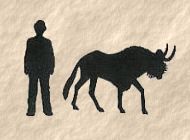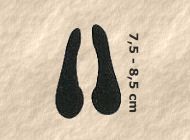 |
 |

Size

Footprint
|
Close this window to go
back to the previous page |
|
Description
|
This ox-like animal is a dark grey-brown with
darker vertical stripes on the neck and flanks. The face, mane, beard,
throat hairs and long horse-like tail are black. The calf has a light
reddish-brown colour and short erect horns. The back slopes downwards. Both
males and females have horns. The Blue Wildebeest can be distinguished from
the Black Wildebeest by its larger size and distribution - it does not occur
on the grass plains of the Highveld. By contrast, the Black Wildebeest's
horns curve forward and the tail is white. |
|
Sexual dimorphism |
Females are considerably smaller than males. |
|
Habitat |
Open bushveld with plenty of shortish grass
and sufficient water. |
|
Habits |
Blue Wildebeest are gregarious, diurnal
animals. The herd of 20 to 30 animals consists mainly of females and young,
with a male as leader. Bachelor herds and very large herds also occur. These
animals prefer to graze while it is cool and rest at midday. They are moving
seasonally in search of good grazing when the grass becomes too tall. They
often mingle socially with Burchell's Zebras which graze on taller grass.
During the mating season the males mark out a certain territory for
themselves. |
|
Voice |
Snort and bellow. Young ones bleat or make a "hunn"
noise. |
|
Breeding |
1, seldom 2, calves are born during November
to February after a gestation period of ± 8½ months. |
|
Food |
Short grass, 15cm or shorter. |
|
Mass |
♂
230 - 270 kg
♀ 160 - 200 kg
|
|
Life expectancy |
± 20 years |
|
Length of horns |
Average ± 60 cm
Record 86,04 cm
|
|
Enemies |
Spotted Hyena, Cheetah, Leopard, Lion, Cape
Hunting Dog. |
|
Also known as |
Blouwildebees (Afrikaans)
Connochaetes taurinus |
|
This
site is best viewed at 1024 X 768
Please report any problems to the Webmaster
Copyright © CoZania October 2004 |



